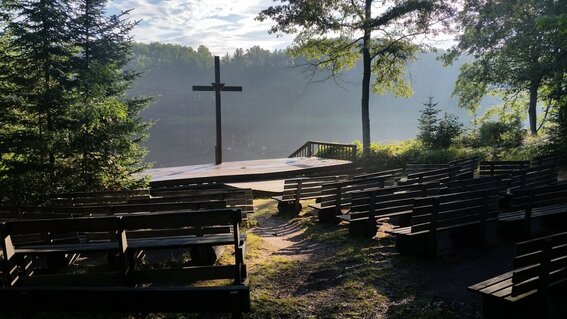The Chapel By Piper Lake - 2020

Piper Lake is a small lake just North of West Branch, Michigan at a summer camp called Camp Timbers. The lake has a brown tint to it caused by the amount of saw dust that covers its bottom. Timbers is built on an old saw mill that provided lumber to the Saginaw lumber industry.
Next to the lake is a small outdoor chapel of wood benches minimal decor. It is one of the most beautiful spots I have ever seen, and sunrises there are unparalleled.
Most importantly, the chapel is a site of personal importance to me in that it was place that I proposed and later married my wonderful wife. I chose to write this piece as her processional to replace the traditional Here Comes the Bride or Canon in D. Small references to Wagner's Here Comes the Bride and Mendelssohn's Wedding March do appear briefly in the piece.
The music is intended to capture the same triumphant and regal aesthetic found in the more traditional bridal entries. It is a progressive build of momentum and excitement until the false climax at measure 30, which marks the arrival point of the piece. There is a brief pause to take a look back at the road traveled. A quiet and intimate moment brings out the bittersweetness in the moment before proceeding to the true climax of letting go of an old life and excitedly delving into the new. The final moments are reduced down to the call, response, and eventual joining of a euphonium-clarinet duet. The closing moments are representative of the moment when my wife and I join hands, as the euphonium and clarinet are the primary instruments of myself and my wife respectively.
Next to the lake is a small outdoor chapel of wood benches minimal decor. It is one of the most beautiful spots I have ever seen, and sunrises there are unparalleled.
Most importantly, the chapel is a site of personal importance to me in that it was place that I proposed and later married my wonderful wife. I chose to write this piece as her processional to replace the traditional Here Comes the Bride or Canon in D. Small references to Wagner's Here Comes the Bride and Mendelssohn's Wedding March do appear briefly in the piece.
The music is intended to capture the same triumphant and regal aesthetic found in the more traditional bridal entries. It is a progressive build of momentum and excitement until the false climax at measure 30, which marks the arrival point of the piece. There is a brief pause to take a look back at the road traveled. A quiet and intimate moment brings out the bittersweetness in the moment before proceeding to the true climax of letting go of an old life and excitedly delving into the new. The final moments are reduced down to the call, response, and eventual joining of a euphonium-clarinet duet. The closing moments are representative of the moment when my wife and I join hands, as the euphonium and clarinet are the primary instruments of myself and my wife respectively.